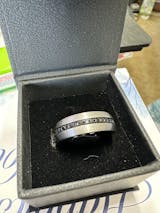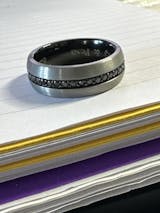
Tungsten rings have gained popularity for their durability and stylish appearance. However, despite their toughness, you might be wondering why these rings sometimes break or crack. Understanding why tungsten rings can break will help you make the best decision for your jewelry selection.
These rings are made from a mixture of tungsten and carbon atoms, creating an impressively hard material known as tungsten carbide. In fact, tungsten carbide is even harder than diamonds and solid gold rings. But with that level of hardness comes a downside: the material can become more brittle and susceptible to breakage.
When exposed to high amounts of force, such as being dropped on a hard surface or struck against something, tungsten rings are more likely to crack or shatter. This is a result of their extraordinary hardness, which prevents them from bending like softer metals such as gold. Instead, they must break when faced with significant force, much like a diamond.
The Material Basics
Tungsten carbide rings are an appealing alternative to traditional metals like gold, silver, and platinum. They offer exceptional hardness, which makes them scratch-resistant and suitable for daily wear. In fact, tungsten carbide measures a 9 on the Mohs scale of hardness, placing it just below diamonds (which score a perfect 10). This feature has helped tungsten carbide rings gain popularity as a sleek and durable option for wedding bands and other jewelry.
However, with such a high level of hardness comes an increased level of brittleness. While tungsten carbide rings can withstand everyday wear and tear, they can break under extreme force or pressure. Activities like hammering or weightlifting could put enough stress on the ring to cause it to shatter if something goes wrong.
Keep in mind that this is a trade-off with other materials. Precious metal rings, like gold, may bend under pressure but are less likely to shatter. Tungsten carbide's ability to break under extreme circumstances can be seen as a safety feature, as it prevents the ring from causing further injury to your finger.

Properties of Tungsten Rings
Tungsten rings are known for their exceptional strength and durability. They are scratch-resistant, making them perfect for people with active lifestyles or those who work with their hands. Tungsten carbide is two to three times harder than titanium and cobalt chrome, which means your ring will maintain its high-quality and luster for a long time.
Despite their scratch-resistant and seemingly indestructible nature, tungsten rings can break under certain conditions. Since they are made from such a hard material, they tend to be more brittle than softer metals like gold. This means that if enough force is applied to a tungsten ring, it may break or crack instead of bending.
In terms of weight, tungsten rings are heavier than their gold or titanium counterparts. Some people appreciate this heftier feel, while others may prefer something lighter. When it comes to color, these rings typically come in two main hues: black and gray. The gray version has a natural metallic luster, while the black variation goes through a process to achieve its darker tone. Both colors maintain their shine over time due to tungsten's tarnish-resistant properties.
Tungsten rings are available in a wide range of styles to suit your taste. Whether you prefer a simple band or a more intricate design, you'll find plenty of options to suit your preferences. Remember, though, that due to the hardness and brittleness of the metal, resizing a tungsten ring can be more challenging than resizing rings made from softer materials.
Quality and Durability Factors
When considering the quality and durability of tungsten rings, it's essential to understand the factors that contribute to their unique characteristics. Tungsten carbide is known for its hardness.
A significant aspect of tungsten rings is their scratch-resistant nature. Due to their hardness, they resist scratching much better than other metals commonly used in wedding bands. This makes them an excellent choice for those who want a ring that can withstand daily wear and tear.
However, the hardness and scratch resistance of tungsten rings also make them brittle. Brittleness means that although they're strong and hard, they can break or crack when exposed to force or pressure from dropping or hitting a hard surface. This is a vital factor to consider, especially for individuals who work with their hands or are prone to accidents.
Tungsten rings can shatter under the right conditions, such as dropping them on a hard surface, throwing them on the ground, or hitting them on a hard object. This vulnerability is due to their rigidity and inability to bend or deform like softer metals.
It's important to note that tungsten rings are not indestructible, despite their reputation as the toughest metal. While they're incredibly durable and scratch-resistant, their brittleness can be an issue.

The Impact of Additives
Tungsten rings are known for their toughness and durability. However, they're not completely indestructible, and one of the reasons they may break is due to the additives used in the manufacturing process. Specifically, the addition of metals such as nickel and cobalt can impact the overall strength and performance of a tungsten carbide ring.
The tungsten carbide used to make rings is often mixed with a binder, usually nickel or cobalt, which helps hold the tungsten and carbon atoms together. The choice of binder can significantly affect the properties of the final ring. Nickel binders are generally considered better because they provide a more durable and less brittle ring compared to those made with cobalt binders.
Cobalt binder, on the other hand, can potentially cause issues. First, it makes the tungsten ring more susceptible to cracking under pressure or impact. Additionally, cobalt has been known to react with the skin, causing irritation or discoloration in some cases. It's worth mentioning that not all tungsten rings with a cobalt binder will cause problems, but it's a factor to consider when looking for a high-quality and durable ring.
On a positive note, there are alternatives to these binders in the making of tungsten rings. Some manufacturers opt for using other metals that offer improved performance and hypoallergenic properties.
Frequently Asked Questions
What causes tungsten rings to fracture?
Tungsten rings can fracture due to their extreme hardness. This hardness makes them more vulnerable to breaking when exposed to large amounts of force, such as being dropped from a high area onto a hard surface or experiencing a significant impact.
How do tungsten rings handle impact?
While tungsten rings are more resistant to scratches and everyday wear and tear than softer metals, their hardness also makes them more brittle. Consequently, they can break or shatter under a heavy impact or if subjected to extreme forces.
Can tungsten rings withstand everyday wear?
Yes, tungsten rings can withstand everyday wear exceptionally well. They are highly resistant to scratches and maintain their shine for a long time, making them a popular choice for wedding bands and fashion rings.
Is tungsten brittle compared to other metals?
Tungsten is indeed more brittle than many other metals typically used in jewelry, such as gold or silver. The hardness of tungsten makes it more susceptible to breaking or cracking under extreme force or heavy impact.
What factors lead to a tungsten ring breaking?
Factors that may lead to a tungsten ring breaking include dropping it onto a hard surface from a significant height, exposing it to a sudden sharp impact, or applying enormous pressure. It's essential to treat your tungsten ring with care to prevent these situations from occurring.
How can I prevent my tungsten ring from breaking?
To prevent your tungsten ring from breaking, avoid exposing it to situations where it may experience extreme force or impacts. Be cautious when handling your ring near hard surfaces and consider removing it when engaging in activities where it may be at risk, such as heavy lifting or contact sports.





